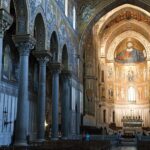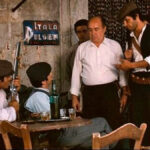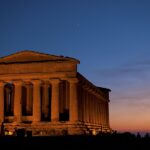Sicily has been a backdrop for some of the world’s most iconic films, from Hollywood classics to intimate Italian masterpieces. The island’s dramatic contrasts – ancient and modern, rugged and refined, traditional and evolving – make it the perfect canvas for visual storytelling.
In this article, I’ll take you beyond the tourist brochures to discover how the silver screen can enhance your Sicilian journey and reveal hidden aspects of our island’s character.
Sicily’s Starring Role in Italian and International Cinema
Sicily’s relationship with cinema is unique – the island isn’t just a pretty backdrop but often serves as a character in its own right. Directors have been drawn to Sicily’s dramatic landscapes and complex cultural identity for decades.
What makes Sicily so compelling for filmmakers is its visual diversity. Within a single day of filming, crews can capture ancient Greek temples, Baroque towns, fishing villages, and Europe’s most active volcano. But beyond these physical attributes, directors come for Sicily’s tangible sense of history – the feeling that the past is never truly past, but continues to shape the present.
Italian neorealism found a natural home in Sicily’s post-war landscape. Directors like Roberto Rossellini and Luchino Visconti used the island to explore themes of social injustice and cultural change. Later, Sicily became central to the mob film genre, though locals have complicated feelings about this association.
In recent years, international productions have increasingly recognized Sicily’s cinematic potential. From big-budget Hollywood productions to critically acclaimed European art films, the island continues to enchant global audiences through the camera lens.
The Godfather Trail: Visiting Iconic Filming Locations
For many international visitors, Sicily first entered their consciousness through Francis Ford Coppola’s masterpiece, “The Godfather.” While Sicilians have a complex relationship with the film’s portrayal of their homeland, there’s no denying its cultural impact and the enduring appeal of its filming locations.
Savoca: The Heart of Corleone
Just outside Taormina lies the hillside village of Savoca, which stood in for Corleone in the first Godfather film. The village’s crown jewel for film enthusiasts is Bar Vitelli, the unchanged establishment where Michael Corleone asked for Apollonia’s hand in marriage.

When I visit, I always order a granita (Sicilian frozen dessert) and sit on the same terrace where Al Pacino once sat. The stone façade draped with vines looks exactly as it did in 1971, creating an uncanny connection between fiction and reality.

A short walk uphill leads to the Church of Santa Lucia, where Michael and Apollonia’s wedding scene was filmed. The view from this spot captures the essence of rural Sicily – rolling hills dotted with small villages and the distant shimmer of the Ionian Sea.
Forza d’Agrò: Preserved in Time
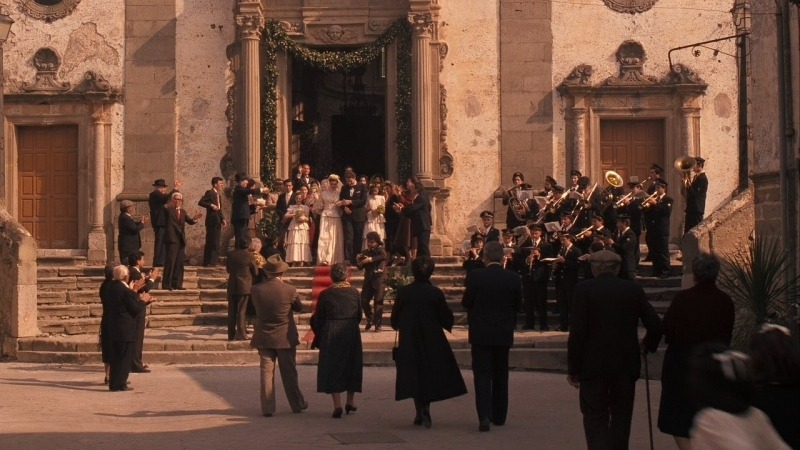
Nearby Forza d’Agrò served as another double for Corleone. The village’s narrow streets, stone archways, and the imposing Church of Sant’Agostino appeared in both The Godfather and The Godfather Part II. What makes this location special is how little has changed – walking through Forza d’Agrò feels like stepping directly into the film.
Practical Tips for Godfather Pilgrims:
- Getting there: Both villages are accessible by car from Taormina (about 30 minutes) or via organized Godfather tours.
- Best time to visit: Early morning or late afternoon offers the best light for photography and helps avoid tour groups.
- Beyond the film: Both villages have authentic charm beyond their cinematic fame – take time to explore their medieval centers and enjoy local cuisine.
- Local perspective: Remember that while these sites welcome film tourists, they’re also real communities with daily life happening around you.
Baaria and Cinema Paradiso: Tornatore’s Sicily
No filmmaker has captured the Sicilian spirit more authentically than Giuseppe Tornatore. Born in Bagheria (which he immortalized as “Baaria” in his semi-autobiographical film), Tornatore’s work offers a more nuanced view of Sicily than international productions often provide.
Cinema Paradiso: A Love Letter to Sicilian Cinema
Tornatore’s most beloved work, “Cinema Paradiso,” won the Academy Award for Best Foreign Language Film in 1990. Though set in the fictional town of Giancaldo, the film was shot primarily in Tornatore’s native western Sicily.
The main square scenes were filmed in Palazzo Adriano, a charming town in Palermo province. The square remains remarkably preserved, and the fountain where young Totò played is still the center of local life. The building that housed the eponymous cinema has been converted to a restaurant, but a small museum dedicated to the film preserves its legacy.
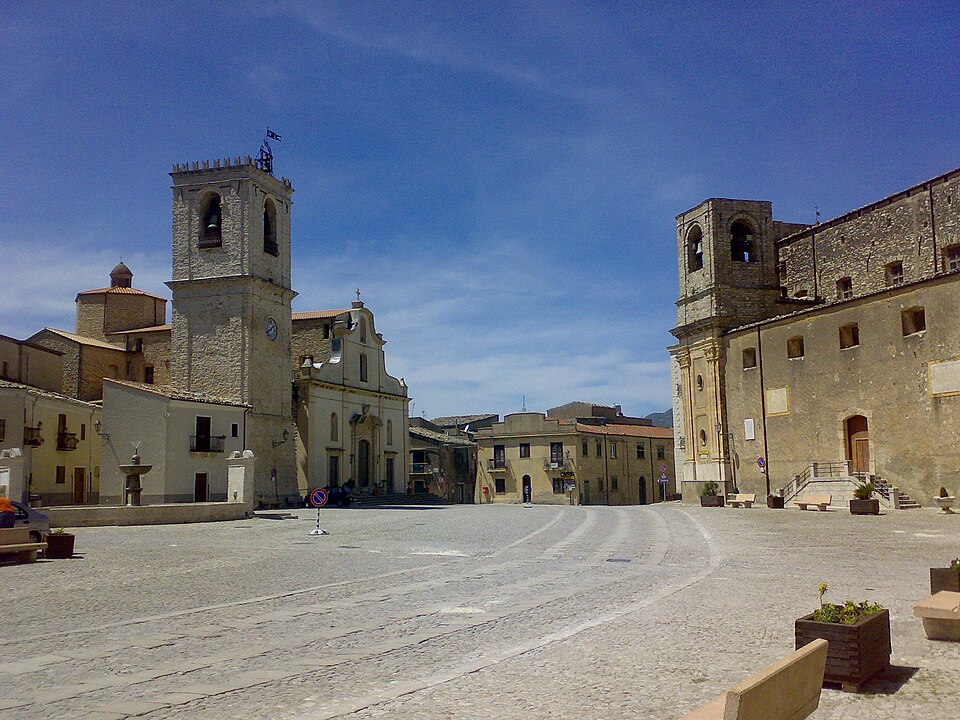
What makes visiting these locations special is experiencing the authentic small-town Sicilian life that the film depicts so tenderly. The rhythms of the piazza, the importance of the church in community life, and the warm interactions between generations – all these elements continue in places like Palazzo Adriano.
Baaria: Tornatore’s Hometown Epic
For an even deeper dive into Tornatore’s Sicily, explore Bagheria (called “Baaria” in Sicilian dialect). This town near Palermo served as the setting for Tornatore’s sweeping historical epic that traces Sicily through the 20th century.
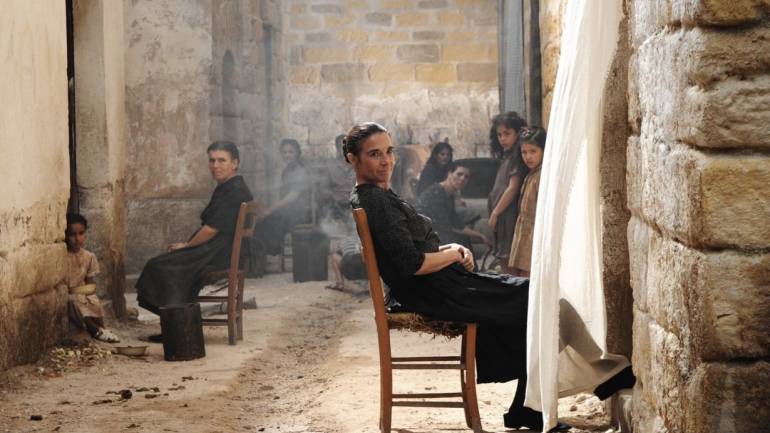
While some scenes were filmed on constructed sets, many of Bagheria’s authentic locations appear in the film. Don’t miss Villa Palagonia, the bizarre “Villa of Monsters” featured in the movie, with its statue-covered walls and mirrored interior.
Where to Experience Tornatore’s Sicily:
- Palazzo Adriano: The heart of Cinema Paradiso, about 1.5 hours from Palermo.
- Bagheria: Tornatore’s hometown, just 15 minutes from Palermo.
- Villa Palagonia: The “Villa of Monsters” in Bagheria, featured in Baaria.
- Cinema Museum in Palazzo Adriano: A small but touching tribute to Tornatore’s most famous work.
Inspector Montalbano’s Southeastern Sicily
Perhaps no fictional character has done more for Sicilian tourism in recent years than Inspector Salvo Montalbano. Based on Andrea Camilleri’s beloved detective novels and brought to television by RAI, Montalbano has introduced millions of viewers to Sicily’s southeastern corner.
The fictional town of Vigàta is primarily filmed in Ragusa Ibla, the stunning Baroque old town of Ragusa. Montalbano’s iconic seafront home is actually located in Punta Secca, a small fishing village in the province of Ragusa. The beach house has become such a popular attraction that the owners have embraced their home’s fame, offering limited tours by appointment.

The Montalbano Effect
What makes the Montalbano phenomenon fascinating is how it has transformed once-overlooked parts of Sicily. Before the series gained international popularity (particularly in the UK and Germany), Sicily’s southeastern provinces received relatively few tourists compared to Taormina or Palermo.
Today, Ragusa, Modica, Scicli, and Noto enjoy a tourism renaissance largely fueled by Montalbano fans. Local businesses have embraced this connection, with restaurants offering “Montalbano menus” and souvenir shops selling commissioner-themed merchandise.
Must-Visit Montalbano Locations:
- Ragusa Ibla: The heart of Vigàta, with its stunning cathedral and the restaurant where Montalbano often dines (Trattoria La Rusticana, renamed “Trattoria San Calogero” in the show).
- Punta Secca: See Montalbano’s beach house and swim at the same beach where he takes his morning dips.
- Scicli: The town hall serves as the Vigàta police station façade in the series.
- Donnafugata Castle: This stunning castle appears as the home of mafia boss Balduccio Sinagra.
Practical Tips for Montalbano Fans:
- Transportation: Unlike the TV show, where Montalbano seems to drive between locations in minutes, the actual filming sites are spread across southeastern Sicily. Renting a car is highly recommended.
- Timing: Many of these Baroque towns are built from honey-colored stone that glows magnificently at sunrise and sunset – plan your photography accordingly.
- Reading material: Bring along one of Camilleri’s novels to read in the actual locations where the stories are set.
The White Lotus Effect: Taormina’s Renaissance
The most recent addition to Sicily’s cinematic landscape came with HBO’s hit series “The White Lotus,” which set its second season in Sicily. Primarily filmed at the San Domenico Palace Four Seasons Hotel in Taormina and various locations across eastern Sicily, the show sparked renewed international interest in the island.
Experiencing White Lotus Locations
The San Domenico Palace, a 14th-century monastery converted into a luxury hotel, is the centerpiece of the White Lotus experience. Even if staying there exceeds your budget (rooms start at around €1,000 per night in high season), you can visit for a cocktail on the terrace overlooking Mount Etna – the same view that served as the backdrop for many pivotal scenes.
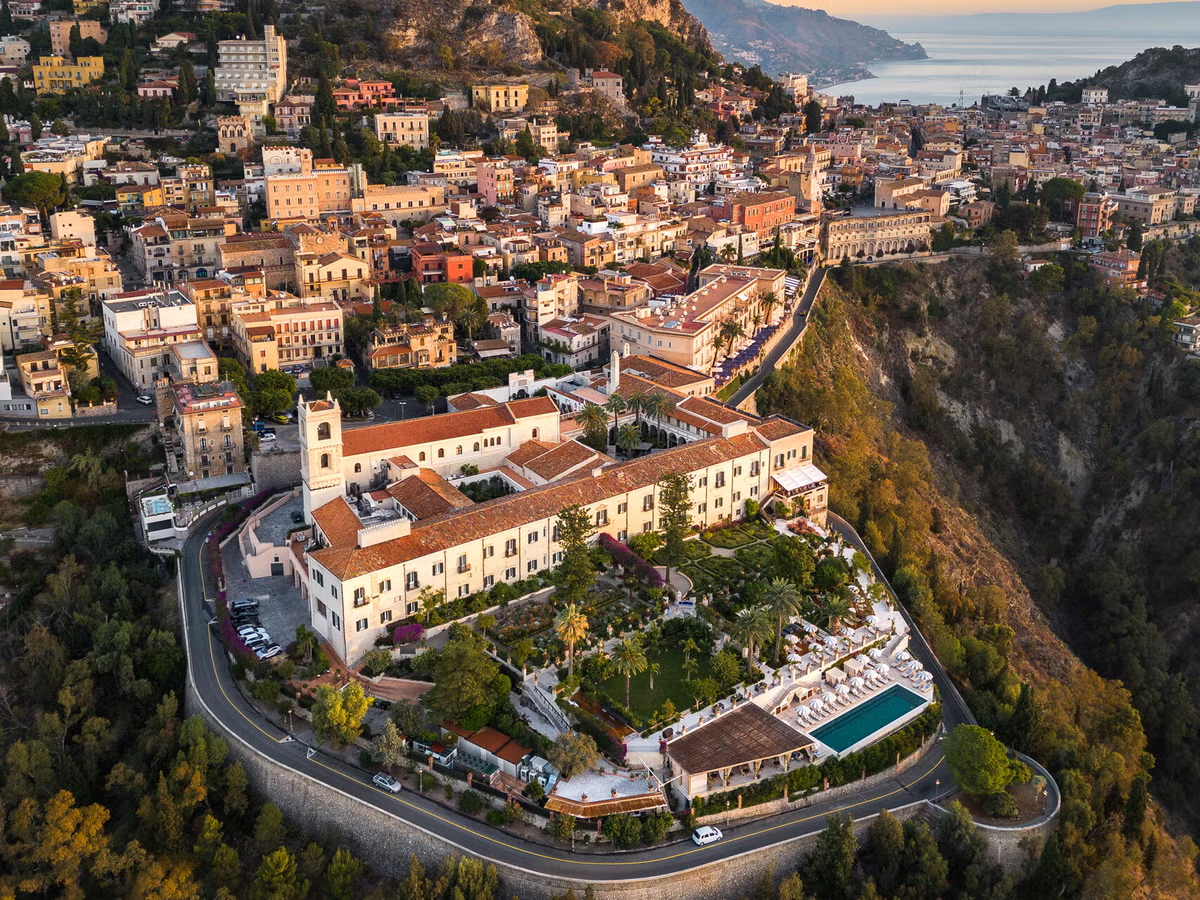
Other significant locations include:
- Taormina’s Ancient Theater: This Greek-Roman amphitheater appears prominently in the series, showcasing its spectacular positioning between mountain and sea.
- Noto: Several characters visit this Baroque jewel, highlighting its honey-colored architecture and elegant atmosphere.
- Cefalù: The beach scenes and the mysterious palazzo were filmed in this charming coastal town west of Palermo.
Beyond the Show
What makes “The White Lotus” locations worth visiting is that they were already Sicily’s crown jewels before the show. Taormina has been Sicily’s premier resort town since the 19th century, attracting literary figures like D.H. Lawrence and Truman Capote long before HBO cameras arrived.
The show merely reintroduced these locations to a new generation of travelers. Visit them not just for their connection to the series, but for their authentic beauty and cultural significance.
Film Festivals and Cinema-Related Events
Sicily’s connection to cinema extends beyond being a filming location – the island hosts several film festivals that draw international talent and showcase both classic and contemporary works.
Taormina Film Fest (June)
Held in the spectacular Ancient Greek Theater with the Mediterranean Sea as its backdrop, the Taormina Film Fest has welcomed Hollywood royalty since 1955. The festival combines international premieres with retrospectives and master classes. Previous attendees include Tom Cruise, Robert De Niro, and Sophia Loren.
The public can purchase tickets to screenings and some events, making this a perfect addition to a summer visit to eastern Sicily. There’s nothing quite like watching a film under the stars in a 2,300-year-old theater.
Ortigia Film Festival (July)
Held on the historic island of Ortigia in Syracuse, this smaller festival focuses on independent Italian cinema and documentaries. Screenings take place in the open air against the backdrop of ancient Greek ruins and Baroque piazzas. The intimate scale allows for interaction with directors and actors in a way larger festivals don’t permit.
Efebo d’Oro Film Festival (November)
Based in Palermo, this festival specializes in films adapted from literary works. Held during the off-season, it offers a perfect opportunity to experience Sicily’s cultural life without the summer crowds. Events take place in historic theaters and palaces throughout the city.
Year-Round Cinema Experiences
Beyond festivals, Sicily offers cinema-related experiences throughout the year:
- Cinema Paradiso Museum in Palazzo Adriano celebrates Tornatore’s classic film with original props and memorabilia.
- Casa Montalbano in Punta Secca offers periodic tours of the detective’s fictional home.
- Historical cinemas like Palermo’s Cinema Excelsior maintain the grand tradition of moviegoing in architecturally significant venues.
Themed Itineraries for Movie Enthusiasts
Based on my experience guiding film enthusiasts around Sicily, I’ve developed several itineraries that combine cinematic sites with authentic local experiences.
The Complete Godfather Tour (3 Days)
Day 1: Savoca and Forza d’Agrò
- Morning: Explore Savoca, visit Bar Vitelli and the Church of Santa Lucia
- Afternoon: Discover Forza d’Agrò and its medieval center
- Evening: Dinner at a traditional restaurant in Taormina
Day 2: Corleone and Palermo
- Morning: Visit the actual town of Corleone and its Anti-Mafia Museum
- Afternoon: Explore Palermo locations featured in The Godfather Part III, including Teatro Massimo
- Evening: Opera performance at Teatro Massimo (where the trilogy’s final scene was filmed)
Day 3: Fiumefreddo and Castello degli Schiavi
- Morning: Visit Castello degli Schiavi near Taormina, where several key scenes were filmed
- Afternoon: Explore the riverside locations near Fiumefreddo that appeared in the films
- Evening: Sicilian cooking class featuring dishes mentioned in the trilogy
Montalbano’s Sicily (4 Days)
Day 1: Ragusa Ibla
- Morning: Walking tour of Ragusa Ibla (the fictional Vigàta)
- Afternoon: Lunch at Trattoria La Rusticana (Montalbano’s favorite restaurant in the series)
- Evening: Sunset photography session at the viewpoints overlooking the Baroque city
Day 2: Scicli and Modica
- Morning: Visit Scicli and the town hall that serves as the Vigàta police station
- Afternoon: Chocolate tasting in Modica, featured in several episodes
- Evening: Dinner featuring seafood dishes mentioned in Camilleri’s novels
Day 3: Punta Secca and Marina di Ragusa
- Morning: Visit Montalbano’s house in Punta Secca and swim at his beach
- Afternoon: Enjoy seafood lunch in a beachfront restaurant
- Evening: Relaxing dinner in Marina di Ragusa, another filming location
Day 4: Donnafugata Castle and Countryside
- Morning: Explore Donnafugata Castle, which appears as mafia boss Sinagra’s home
- Afternoon: Visit rural locations from the series, including authentic masserie (farmhouses)
- Evening: Farewell dinner at a countryside restaurant
Sicily on the Silver Screen (7 Days)
This comprehensive tour combines multiple cinematic influences:
Days 1-2: Palermo and Western Sicily
- Bagheria (Tornatore’s Baaria)
- Palazzo Adriano (Cinema Paradiso)
- Corleone and surroundings
Days 3-4: Taormina and Eastern Sicily
- San Domenico Palace (White Lotus)
- Savoca and Forza d’Agrò (The Godfather)
- Ancient Theater of Taormina (featured in many films)
Days 5-7: Southeastern Sicily
- Ragusa, Modica, and Scicli (Montalbano)
- Noto (White Lotus and various Italian productions)
- Syracuse and Marzamemi (settings for numerous films)
Beyond the Screen: The Real Sicily
While following in the footsteps of favorite films and TV shows provides a wonderful framework for exploring Sicily, the most memorable experiences often happen when you venture beyond the established cinematic routes.
Between visiting filming locations, make time to:
- Connect with locals: Sicilians love discussing how their homeland is portrayed on screen – ask for their opinions on famous films set on the island.
- Explore food culture: Sicily’s cuisine varies dramatically from region to region, reflecting the island’s diverse cultural influences.
- Discover hidden corners: Some of Sicily’s most magical places have never appeared on film – follow local recommendations to find them.
- Slow down: The Sicilian pace of life is part of the island’s charm. Schedule downtime to sit in piazzas, observe local life, and absorb the atmosphere that has inspired filmmakers for generations.
Practical Tips for Film-Inspired Travel
When to Visit
- April-June and September-October offer ideal weather for exploring filming locations without summer crowds and heat.
- Film festivals (primarily June and July) provide unique cultural experiences but require advance planning.
- Winter months provide the atmospheric lighting and empty landscapes seen in many Sicilian films.
Getting Around
- Rental car is essential for reaching remote filming locations, particularly for Montalbano sites.
- Private guides specializing in film tourism can provide context and access to locations not easily found.
- Public transportation works well for major cities but is limited for rural film locations.
Accommodations
- San Domenico Palace in Taormina for the ultimate White Lotus experience (budget permitting)
- Small hotels in Ragusa Ibla for Montalbano enthusiasts
- Agriturismo (farm stays) in the countryside for an authentic experience of rural settings featured in many films
Creating Your Own Cinematic Experience in Sicily
While this guide focuses on established filming locations, some of Sicily’s most cinematic spots have yet to be captured on film. As you plan your journey, consider adding these visually stunning locations that feel straight out of a movie, even if they haven’t officially appeared on screen.
The Abandoned Worlds of Sicily
Sicily is dotted with ghost towns and abandoned places that would make perfect settings for post-apocalyptic films or period dramas. The earthquake-abandoned town of Poggioreale in western Sicily offers hauntingly beautiful ruins where you can wander through empty streets that nature is slowly reclaiming.
Similarly, the abandoned Fiat 500 factory near Termini Imerese creates an industrial landscape that has attracted photographers and urban explorers but has yet to be used in major productions.
Dramatic Natural Settings
The lunar landscape of Vulcano island in the Aeolian archipelago, with its smoking craters and sulfur springs, creates an otherworldly atmosphere that feels like science fiction. Meanwhile, the towering rock formation of Rocca di Cefalù looms over the coastal town like a natural movie set, particularly dramatic at sunset.
In the interior, the man-made lakes of central Sicily create mirror-like reflections of the surrounding mountains, particularly at Lake Pergusa and Lake Pozzillo – perfect backdrops for contemplative scenes.
City Corners with Cinematic Appeal
In Palermo, the crumbling grandeur of Palazzo Lampedusa (childhood home of the author of “The Leopard”) evokes a sense of faded aristocratic splendor. The hidden courtyards of Ortygia in Syracuse feel like movie sets with their stone archways draped in flowering vines and centuries of patina.
And for those seeking more contemporary cinematic vibes, the street art district of Catania near Via Pistone showcases vibrant murals that transform ordinary streets into visually striking backdrops.
Photography Tips for Film Location Visitors
Capturing your visits to famous film locations requires some specific techniques to recreate the cinematic quality that made these places iconic. Here are some professional tips from my experience photographing Sicily’s film locations:
Technical Considerations
- Time your visits for golden hour: Many Sicilian films make excellent use of the warm, golden light in early morning or late afternoon. This lighting is particularly stunning in honey-colored towns like Noto and Ragusa Ibla.
- Use a wide-angle lens: To capture the sweeping landscapes of The Godfather or the architectural grandeur in White Lotus, a wide-angle lens helps recreate the expansive feel of cinematic shots.
- Consider aspect ratio: For a truly cinematic feel, crop your photos to a 16:9 or 2.35:1 aspect ratio that mimics widescreen cinema.
- Shoot from unusual angles: Directors rarely place their cameras at eye level. Experiment with low or high angles to create more dramatic compositions.
Composition Ideas
- Frame characters in doorways: Many memorable scenes in Sicilian cinema (especially in The Godfather and Montalbano) feature characters framed by doorways or windows. Use these architectural elements to frame your travel companions or local scenes.
- Capture daily life: The most authentic Sicilian films incorporate everyday moments – fishermen mending nets, elderly men playing cards in piazzas, women hanging laundry between buildings. These elements add authenticity to your location photos.
- Contrast old and new: Many Sicilian directors play with the juxtaposition of ancient and modern elements. Look for these contrasts in your compositions.
Specific Location Recommendations
- Bar Vitelli (Savoca): Arrive early morning before other visitors and capture the sunlight illuminating the stone façade and terrace.
- Montalbano’s House (Punta Secca): Photograph at dawn when the beach is empty and the light is similar to the opening credits of the show.
- Taormina Ancient Theater: Visit in late afternoon when the sunlight creates dramatic shadows and Mt. Etna is clearly visible in the background.
- Palazzo Adriano Square: Capture local life in the early evening when residents emerge for the traditional passeggiata, just as in Cinema Paradiso.
The Impact of Film Tourism on Sicilian Communities
As a local, I’ve witnessed firsthand how film tourism has transformed certain Sicilian communities. This phenomenon comes with both benefits and challenges that are worth understanding as you visit these locations.
Economic Revitalization
The Montalbano effect has breathed new life into small towns like Scicli and Punta Secca. Before the series gained international popularity, these communities struggled with depopulation and economic stagnation. Today, restaurants, B&Bs, and shops catering to Montalbano fans have created jobs and opportunities that allow younger residents to remain in their hometowns.
Similarly, Savoca has been transformed by Godfather tourism. The owner of Bar Vitelli has told me that without the steady stream of film tourists, maintaining a business in such a small village would be impossible.
Cultural Preservation vs. Commercialization
In some locations, increased tourism has helped fund the restoration of historic buildings and traditions. However, there’s a delicate balance between preservation and commercialization. In places like Corleone (which, ironically, wasn’t used as a filming location), some residents express frustration at being primarily associated with mafia stereotypes rather than their rich agricultural heritage and anti-mafia activism.
When visiting these communities, remember that they’re not just film sets but living places with complex identities that extend far beyond their cinematic portrayals.
Responsible Film Tourism
To ensure your film tourism has a positive impact:
- Support local businesses: Choose family-run accommodations and restaurants rather than international chains.
- Respect privacy: Many filming locations are in residential areas or private properties. Always ask permission before photographing people’s homes.
- Look beyond the famous scenes: Take time to discover aspects of these communities that weren’t featured on screen.
- Learn local context: Understanding the real history and culture behind the cinematic representations enriches both your experience and your interactions with locals.
Frequently Asked Questions
What part of Sicily was The Godfather filmed in?
The Godfather was primarily filmed in eastern Sicily, with key locations in the hillside villages of Savoca and Forza d’Agrò near Taormina. These towns stood in for Corleone (Francis Ford Coppola chose not to film in the real Corleone as it had become too modernized). Other significant locations include Castello degli Schiavi in Fiumefreddo, which served as Don Tommasino’s villa. For The Godfather Part III, several scenes were filmed in Palermo, most notably at Teatro Massimo for the opera finale.
Can you visit Inspector Montalbano’s house?
Yes, Montalbano’s iconic seafront house is located in the small fishing village of Punta Secca in the province of Ragusa. The exterior is easily visible from the public beach. The building is privately owned and occasionally opened for limited tours by arrangement. Even when closed to visitors, you can swim at the same beach where Montalbano takes his morning dips in the show’s opening scenes and dine at nearby restaurants featured in the series.
Where was White Lotus Season 2 filmed in Sicily?
The second season of White Lotus was primarily filmed at the San Domenico Palace Four Seasons Hotel in Taormina, a converted 14th-century monastery with spectacular views of Mount Etna and the Ionian Sea. Additional locations included Noto (where several characters take a day trip), Cefalù (for beach scenes and the mysterious palazzo), and various spots around Taormina including the Ancient Greek Theater. The scenes at a family-run villa were filmed at Palermo’s Villa Tasca.
What is the best time of year to visit Sicilian filming locations?
Spring (April-June) and early autumn (September-October) offer the best combination of pleasant weather and manageable crowd levels. Many locations, particularly in Taormina and the southeast, become extremely crowded in July and August. Winter visits (November-March) provide a more authentic experience with very few tourists, though some seasonal businesses in smaller towns may be closed, and weather can be unpredictable.
Are there organized tours of film locations in Sicily?
Yes, numerous companies offer specialized film location tours, particularly for The Godfather and Inspector Montalbano sites. These range from full-day excursions departing from major cities like Catania and Palermo to multi-day themed itineraries. While organized tours provide convenient transportation and expert commentary, independent travelers with rental cars can easily create their own film-focused itineraries using the information in this guide.
Conclusion: Finding Your Own Sicilian Story
Cinema has the power to transport us, but standing in the actual locations where beloved films were created offers a deeper connection – both to the films themselves and to the cultural context that inspired them.
As you explore Sicily through its cinematic heritage, remember that the island continues to write its own story. Today’s authentic experiences – a conversation with a fisherman in Punta Secca, a sunset viewed from Taormina’s ancient theater, or a meal shared with a Sicilian family – might become tomorrow’s cinematic inspiration.
Sicily’s relationship with cinema is reciprocal: films have shaped how the world sees Sicily, but Sicily continues to shape how filmmakers understand themes of tradition, change, beauty, and resilience. By experiencing both the cinematic island and the real one, you’ll gain a richer appreciation of both.
Whether you’re following in the footsteps of Michael Corleone, Inspector Montalbano, or the troubled guests of the White Lotus, Sicily offers an unforgettable journey through living film sets that continue to captivate both filmmakers and travelers.
Ready to Plan Your Film-Inspired Sicilian Adventure?
Which cinematic locations are you most excited to visit? Let me know in the comments below, or share your own experiences from Sicily’s famous film spots!



